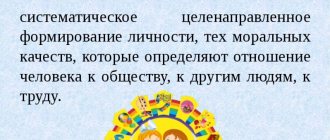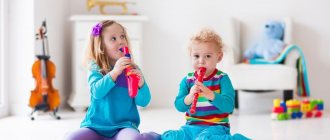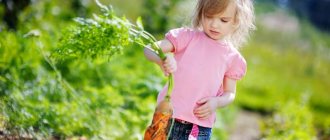Criteria for environmental education of older preschoolers
The famous teacher and scientist T. A. Markova believes that the main criteria can be:
- children's goodwill towards all living things;
- degree of interest in living and inanimate nature;
- desire to contact natural entities;
- ability to care for plants and animals.
Ecological culture allows you to live in harmony with the surrounding nature, feel responsible for your steps and understand the consequences of a harmful attitude towards the earth.
READING IS THE BEST STUDY
Preschool age is the time when reading books evokes the most vivid emotional response in a child, makes you empathize and think about what you read. The conclusions drawn after reading the book remain in the child’s memory for a long time.
Literature on environmental education is, first of all, the works of V. Bianchi. In the form of entertaining stories or fairy tales, they help the child understand complex natural phenomena, the patterns of the natural world, talk about the interaction of the organism with the environment, and the forms of its adaptation to its habitat.
You can also tell a preschooler about the beauty and diversity of native nature using the examples of the works of M. Prishvin, F. Tyutchev, A. Pushkin, A. Fet, K. Ushinsky, N. Nekrasov, L. Tolstoy, N. Sladkov and others.
Reading children's encyclopedias devoted to natural areas, climate, animals, and plants will also be useful in terms of improving environmental education. Bright pictures in them contribute to more effective memorization of accurate information. But fairy tales, proverbs and sayings, which can also be classified as “ecological”, carry figurative information, which is also useful.
Raising a child begins in the family. The harmonious development of children in the future depends on how correct it is. In environmental terms, too.
THE BEST TOOL OF EDUCATION IS GAME
This is true. Gaming activities develop, educate, teach. At the same time, it is fun, interesting, without coercion. So the development of a child through didactic games is one of the most effective means of teaching environmental (and any other) literacy.
The game can be played both during walks and outside.
In the first case, a preschooler can study the appearance and properties of earth, water, clay, sand, ice, and snow. For example, you can offer your child:
- play snowballs;
- To make a snowman;
- hold the ice in your hands, breathe on it;
- make a sun or a tower out of ice floes;
- make Easter cakes from sand;
- compare clay and earth by touch;
- make bricks from clay;
- pass water mixed with clay through a layer of sand;
- compare how sand and clay behave in water, etc.
In the second case, you can arrange a family game at home, inviting friends to visit. These could be, for example, games in the form of lotto:
- What grows where?
- Who lives where?
- Who eats what?
In this case, you need to choose among the lotto cards those that correspond to the environment depicted on each card.
Games in the form of quizzes:
- find by description (you need to find a picture that matches the description of a bird, animal, season);
- recognize and name (recognize an animal or bird by sounds, tracks);
- when does this happen (determine the time of year, natural phenomenon from the description).
There are many educational games on ecology. You can throw a ball to a child, naming a general class (for example, pets), and in response the child, having caught the ball, must give an example. You can arrange a competition to see who can best draw what is described on the card in text format. Or divide the children into 2 groups and ask them to unite in such a way that the upper parts of the plants in the pictures of some coincide with the lower parts of the pictures of others (tops and roots). You can ask kids to imitate the movements of the birds or animals shown in the picture. Or ask them to remove an extra link in some chain of images...
Creating a favorable ecological environment
The process will be successful when a favorable, positive ecological environment is created around the child.
The presence of experimental plots in the garden, an ecological trail, a winter garden, an aquarium, and a living corner makes it possible to increase the efficiency of all forms and methods of work in this area.
There should be no unfoundedness. Children need to see everything in person, touch it, smell it, stroke it. Then the common efforts of educators and parents will bring results.
WHAT DOES THIS LOOK LIKE IN PRACTICE?
Behind all these seemingly sophisticated concepts lies a daily work that is invisible to the child. The peculiarities of the formation of thinking, as we remember, at this age are expressed by objectivity and clarity. Therefore, when going for a walk or going into nature, parents ask the child to evaluate what changes in nature have occurred recently (flowers have bloomed, dandelions have turned grey, chicks are chirping in the trees, it has become slushy, birds have flown away, snow has fallen, etc. ).
Working in the garden or vegetable garden, the child gains knowledge about what period of the year what work should be done in order for flowers to bloom, fruits and vegetables to ripen. At the same time, you can explain to him why butterflies flying around, beetles, ants, birds are needed, what their benefits and relationships are. Tell them that they all have their own home, their parents have kids that they take care of and are very worried when something happens to them - just like people.
By their example, adults show a creative attitude towards nature (water, feed, loosen), explain that squashing bugs, catching butterflies, breaking branches just like that is inhumane (and they themselves do not do this). At the same time, you can touch the grass, smell the flowers, enjoy the singing of birds, observe the changes that occur every day (this is where the calendar comes in handy), and draw conclusions about the laws of nature.
During family environmental events, children will learn what trees are for, why it is so important to take care of them, why one should not litter the environment with waste, and how important it is to feed the birds in the garden, yard, and park in winter.
It’s good if the child starts asking a lot of questions about this in order to expand the range of existing knowledge and systematize the information received.
Advice
If your baby doesn’t bombard you with “why” questions, ask him yourself. Provoke your child to think, compare, and draw conclusions. (Why do you think the sunflower closed its cap? Why is the berry in the sun already red, but under the leaf not yet? What will happen if bees don’t fly into our garden? Why do trees shed their leaves?). Find answers together. This is a good tool not only for environmental education, but also for the development of preschoolers’ speech.
When a child takes care of an indoor flower or animal, adults also teach him to create, preserve, and help. Their stories, accompanied by visual, lively pictures, are not perceived by the child as teaching. This is a natural process. The formation of environmental consciousness in preschool childhood should take place unnoticed.






